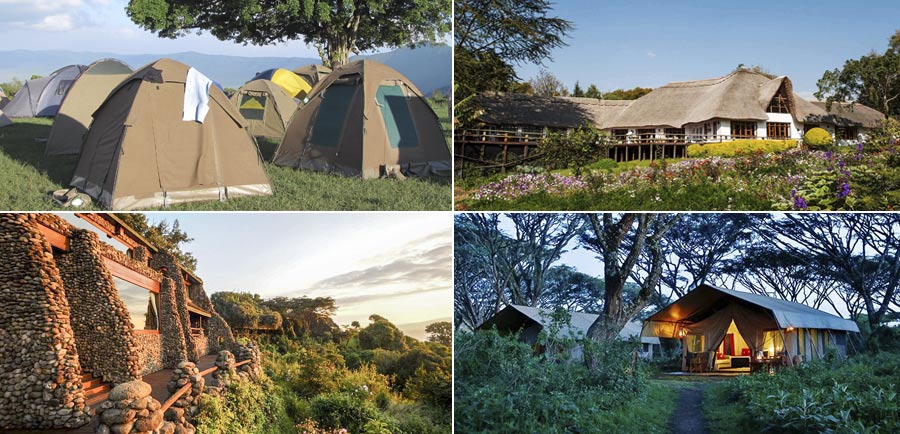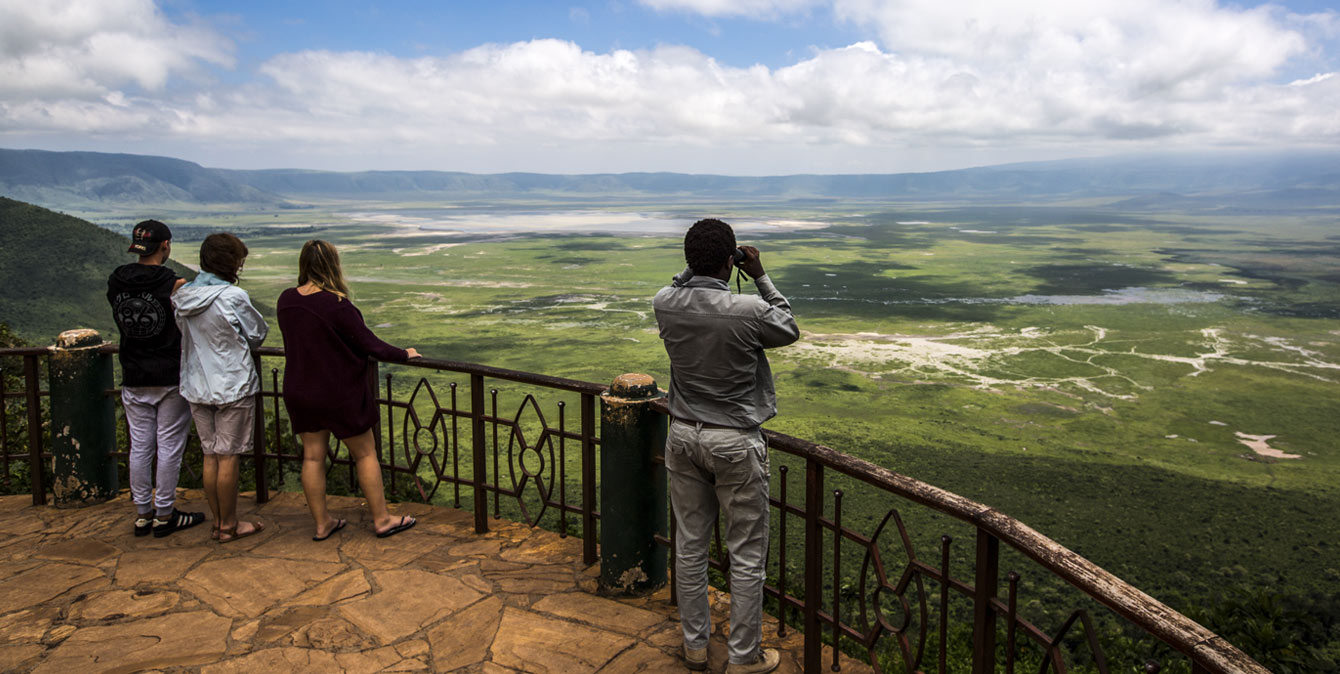Ngorongoro Crater Safaris & Tours. A Complete Guide
The Ngorongoro crater is a visual masterpiece, home to thousands of wildlife, and breathtakingly beautiful. For many visitors on a safari in Tanzania, the highlight of their trip will be going on a Ngorongoro crater safari; a visit to a World Heritage site, and one of the few places in Tanzania you can spot all the “BIG 5” animals in one day – Lion, Elephant, Leopard, Buffalo, and Rhino.
 A safari to Ngorongoro crater can be done as a day trip starting with a drive from Arusha to Ngorongoro (approximately 3.5-hour drive) or can be included in a multi-day Tanzania safari package that combines a tour to Ngorongoro crater with a visit to other national parks such as Serengeti, Lake Manyara, and Tarangire or can be combined with a visit to some of the lakes that flank the Ngorongoro conservation area, the most popular of these are Lake Eyasi and Lake Natron.
A safari to Ngorongoro crater can be done as a day trip starting with a drive from Arusha to Ngorongoro (approximately 3.5-hour drive) or can be included in a multi-day Tanzania safari package that combines a tour to Ngorongoro crater with a visit to other national parks such as Serengeti, Lake Manyara, and Tarangire or can be combined with a visit to some of the lakes that flank the Ngorongoro conservation area, the most popular of these are Lake Eyasi and Lake Natron.
So Where is Ngorongoro Crater Located?
Ngorongoro Crater, located in the Ngorongoro conservation area, is found west of the Great Rift Valley, which runs from the Red Sea in Jordan all the way through from North and Eastern Africa down to Lake Nyasa in southern Tanzania.
From Arusha town, The Ngorongoro crater is located a distance of 180 Kilometers (112 miles), Northwest of Arusha town and can be reached by car through a well-tarmacked road from Arusha to the main gate of the Ngorongoro conservation area, the drive takes approximately 3.5 hours.
What is the Size of Ngorongoro Crater?
The Ngorongoro Crater is oval; with a diameter of approximately 19 km (12 miles) and measures a size of 300 Sq. kilometres (115Sq. miles) in area and 610 meters (2000 feet) deep, it is on the crater floor where most of the Ngorongoro crater safari tours take place.
Price of Ngorongoro Crater Safaris
The price of safaris to Ngorongoro crater can cost anywhere between $ 170 and $1000+ per person per day.
- A budget safari to Ngorongoro averages $170 per person per day; this price is for group safari on a camping accommodation.
- A Mid-range lodge Ngorongoro crater safari costs about $ 350 to $650 per person per day depending on the number of people travelling.
- A Luxury safari to the Ngorongoro crater can cost about $750 to $1500 per person per day for the extreme luxury Ngorongoro safaris.
Best Time to Visit Ngorongoro Crater
 When is the best time to go on a safari to Ngorongoro crater?
When is the best time to go on a safari to Ngorongoro crater?
There is no search thing as the best time to go on a Ngorongoro crater safari, reason being, game viewing is possible throughout the year because of the large number of wildlife that is permanent resident to the Ngorongoro crater due to abundance of food and water.
However, the ideal time to go on safari to Ngorongoro crater may differ for every individual as much of it comes down to personal taste and specific interests, hence the term best time go on a Ngorongoro crater safari.
Ngorongoro Safari – does the time of day really matter?
Generally, as with any wildlife safari, the early bird catches the worm.
- Arriving in the early morning, you may catch predators still on the evenings kill or diurnal hunters just about to take breakfast.
- Elephants are more active before the heat of the day sends them to shade and sleep.
- The best time to see Rhinos in the Ngorongoro crater is around lunchtime/afternoon when the sun is hotter as they will be more active so maximise your time in the crater.
Crowds! Getting there first always wins over those who simply cannot or will not move without their shower/Coffee/Cigarette/Breakfast and a read of the newspaper.
Except for the kills I find that the Ngorongoro crater is great early morning, lunchtime, and the evening. Pick any two or more and I guarantee you will have an exceptional Ngorongoro safari.
Best months to go on a Ngorongoro Crater safari
| January to May | June to October | November to December |
| Game Drives | Game Drives + Walking Safaris | Game Drives |
The best months for game viewing safari in the Ngorongoro crater is during the dry season, from June to October: This is the time of the year when the weather in Ngorongoro is favourable to most travellers.
During these dry months of the year, the Ngorongoro receives abundant sunshine and there is little to no rainfall hence the grass is short and general wildlife viewing is at its best.
This is also a great time for guests who would like to go on walking safaris in the Ngorongoro conservation area.
The rainy and tourism low season from March to May: This is the time of the year when the rains come pouring.
The weather in the Ngorongoro crater can be chilly during this time and the roads may not be in good condition, but, you will still be able to spot wildlife.
This period is also the only time when the Ngorongoro crater has fewer crowds.
Accommodation prices are also at the lowest price and general Ngorongoro safari prices are at the lowest cost too.
For Ngorongoro crater safari bargain hunters, this is the perfect time to go on safari to Ngorongoro crater and Tanzania in general.
Ngorongoro Crater Wildlife
 What animals are found in the Ngorongoro crater?
What animals are found in the Ngorongoro crater?
Today, the Ngorongoro crater shelters the most beautiful wildlife haven left on the planet with a spectacular concentration of wildlife and stunning views from the highland rim.
The Ngorongoro crater is home to over 25,000 large mammals within the crater itself.
The Ngorongoro crater is undoubtedly the best place to see black rhino in Tanzania as well as prides of lion that include the magnificent black-maned males.
All of the big five animals are seen in a Ngorongoro crater safari – elephant, rhino, lion, leopard, and buffalo.
Other game that can be found while on a safari in Ngorongoro includes cheetah, hyena, zebra, warthog, impala, hartebeest, eland and lots of other members of the antelope family and smaller mammals of sorts.
Birdlife – More than 100 species of birds, which are not found in the Serengeti, have been found in the Crater.
Some of the birdlife in the Ngorongoro crater that you will encounter during a safari to the Ngorongoro include Kori bustards, secretary birds, crested cranes, marabou storks, goliath herons, soaring fish eagles, and thousands of colourful flamingos.
Ngorongoro crater Vegetation – The Crater rim is wooded with mountain forest vegetation and in certain season blooms with pink, blue and white lupines, candle white lilies, and mauve-blue hyacinths.
Ngorongoro Conservation Area Attractions
While the Ngorongoro crater is the single most visited tourist site in Tanzania, the rest on the Ngorongoro conservation area offers many rewards for those visitors prepared to explore further afield.
Some of the attractions in the Ngorongoro conservation area can be visited en-route to Serengeti; others will require a special visit, but they are well worth the effort.
 Below is a list of Ngorongoro Tours & Attractions.
Below is a list of Ngorongoro Tours & Attractions.
|
|
Ngorongoro Lodges & Camps
What accommodation is in the Ngorongoro crater? There is No accommodation or camping facilities within the Ngorongoro crater its self, however, there is a varied choice of accommodation perched on the crater rim, most of these Ngorongoro crater safari lodges and camps offer amazing views to the crater floor.
There is also an option of staying in the nearby town, Karatu town, which offer a diverse option of accommodation to travellers of all budgets.

Some of the accommodation in the Ngorongoro Conservation Area
- Budget Camping – Simba A public Campsite.
- Mid-range Lodging – Ngorongoro Rhino Lodge & Ngorongoro Wildlife Lodge.
- Luxury Lodging – Ngorongoro Serena Lodge & Ngorongoro Sopa Lodge.
The type of accommodation around the Ngorongoro crater varies from budget camping at a public campsite, mid-range lodges to high-end luxury lodges and tented camps.
The Ngorongoro and surrounding areas are well serviced with accommodation properties and I believe our team can assist you to get accommodation of your budget and choice.
6 Interesting Ngorongoro Facts
- Our Earliest Human Ancestors lived in the Ngorongoro Conservation Area.
- Ngorongoro Crater is the largest unbroken caldera in the world and the second-largest extinct crater in the world.
- When it was a volcano it’s thought to have been a similar size to Mount Kilimanjaro, one of the world’s highest mountains.
- Approximately 50,000 people live in the conservation area. They share the land with an incredible amount of wildlife.
- You won’t find any giraffes inside the Ngorongoro crater; however, you’ll still be able to find them around the crater rim.
- The Ngorongoro Crater is also referred to as ‘the Garden of Eden’ due to its dazzling beauty and being a paradise for animals.



